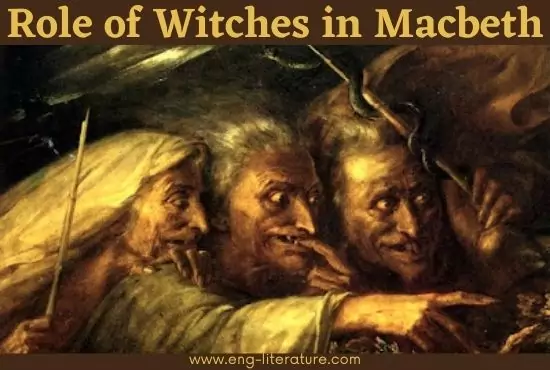Role of Witches in Macbeth
Many critics are of opinion that the witch scenes are interpolations. Cunningham thought that Act I, Sc i was written by Middleton. The Hecate scenes – III, V and IV, i are also thought to be from Middleton The Witch. It may be pointed out that The Witch-was not written until 1616. It is also impossible to believe that the two songs of Hecate scene were added to Macbeth. Kenneth Muir suggests that Middleton himself was influenced by Macbeth, when he wrote The Witch.
Shakespeare’s witches play a very important part both on dramatic and symbolic levels. We do not know Shakespeare’s personal opinion of witchcraft whether he accepted the tenets of James Demonologie or whether he adhered to the sceptical position of Reginal Scot. But the belief in witchcraft could be used by him for dramatic purposes.
Shakespeare has made significant departures from Holinshed in his characterization of the witches. In Holinshed’s chronicles, there are wizard, a witch and the weird sisters. The sisters predict that Macbeth will be king, the wizard warns against Macduff, and the prophecy about Birnam wood comes from the witch. Shakespeare makes them all into one. He invests them with a certain mystery. They meet in thunder, lightning or in rain, and ‘hover through the fog and filthy air’.….., their aim is to ‘wreck the state of man’.
In their nature and aspect, Witches look not like the inhabitants of the earth, they seem ‘corporeal’ but ‘melt into the air’ like the ‘bubbles of the earth’. The mystery about them is heightened by their attachment to such abominable creatures as ‘paddocks’ and ‘graymalkins’. They are anomalies of Nature. They have withered looks, their fingers are choppy, their lips skinny, their attire wild. They look like women, yet they are bearded. Their favourite sport is to kill swine for nothing. Another will take revenge on a sailor’s wife who has denied her a handful of chestnut. Thus they are mischief-making beings. Witches are earthy as well as airy. They are objective as well as symbolic.
The witches are indeed demons or devils in the form of witches. They are elemental beings with something sublime and abysmally evil about them. Their prophecies on Macbeth are a mere influence and nothing more. They present to Macbeth dangerous circumstances which Macbeth has to tackle. They tempt Macbeth only because they know his ambitious dreams. The first scene of the play, as L. C. Knights has noted, ‘strikes one dominant chord’ and that chord is evil. ‘Fair is foul and foul is fair’ underlines the appearance-reality theme, what appears fair – a prophecy, a hostess, a pleasant castle – lurks what is foul: ambition, deception, corruption and murders.
Their prophecy of the crown does not dictate evil means of achieving it – it is morally neutral. Macbeth himself never thinks of blaming the weird sisters for tempting him to the murder of Duncan, though he blames the ‘juggling fiends’ who have lulled him into a false sense of security. He knows that the first step along the primrose path was taken on his own responsibility. Wilson Knight points out:
“They are not fates or anything corresponding to that conception, for Macbeth exercises complete freedom of will from first to last”.
So, the weird sisters have no direct share in the action of the drama. But the influence of the witches, or rather, of the evil satanic forces they represent is a pervasive one and seems to affect in some subtle mysterious way both Macbeth and Lady Macbeth, and influences their thoughts and actions. In the great soliloquy, ‘come, you spirits, that tend on mortal thoughts’, she was in fact invoking the powers of Hell to take possession of her body.
Also Read:
The witches represent forces of disorder, disintegration and anomalies. In their combination of grossness and sublimity, hideousness and mystery they suggest the very spirit of the play. They introduce us to a world where values are topsy-turvy – ‘good things of day droop and drowse and night’s black agents to their preys do rouse. Wilson Knight very aptly points out that “throughout the tragedy runs the suggestion of life threatening, ill-omened, hideous”. The witches suggest the darkness mystery, abnormality and hideousness of the Macbeth universe. ‘Weird sisters are nightmare actualized.’ So, the presence of the witches contribute to the play’s atmosphere of horror, mystery and abnormality. They symbolise the dark forces at work in the play.
Apart from the function of the witches, we should look at their place in the structure of the play. The light rhyming couplets of their incantations contrast with the heavy evil they are bent on conjuring in the mind of man. They sound the notes of superstition with their magic numbers, their ritual revolving around the number three.
The enigmatic or ambiguous nature of the witch’s prophecies reflects the enigmatic nature of man himself, subject to evil actions or thoughts unless ruled by what is natural. The cauldron incantation is singularly expressive with its list of animal and fleshly parts as invocation, all peculiarly appropriate when we think of the final description of Macbeth as a ‘butcher’. The phrase “Double, double, toil and trouble” while it defines Macbeth’s state and actions echoes as well the key word ‘double’ much used in the play to indicate extreme force or deception.
Significantly, the show of eight kings is completed by a ninth apparition following that of the ‘blood-boltered Banquo’, thus making up the magic number of nine. By a considered linking therefore, Shakespeare has connected the natural, the supernatural and the unnatural.

Hello, Viewers! Besides being the Founder and Owner of this website, I am a Government Officer. As a hardcore literary lover, I am pursuing my dream by writing notes and articles related to Literature. Drop me a line anytime, whether it’s about any queries or demands or just to share your well-being. I’d love to hear from you. Thanks for stopping by!
